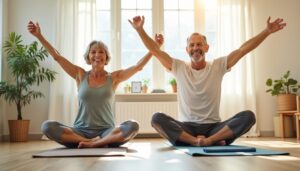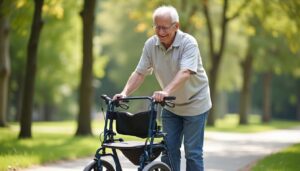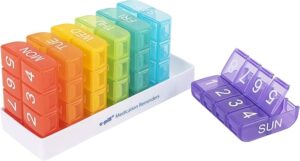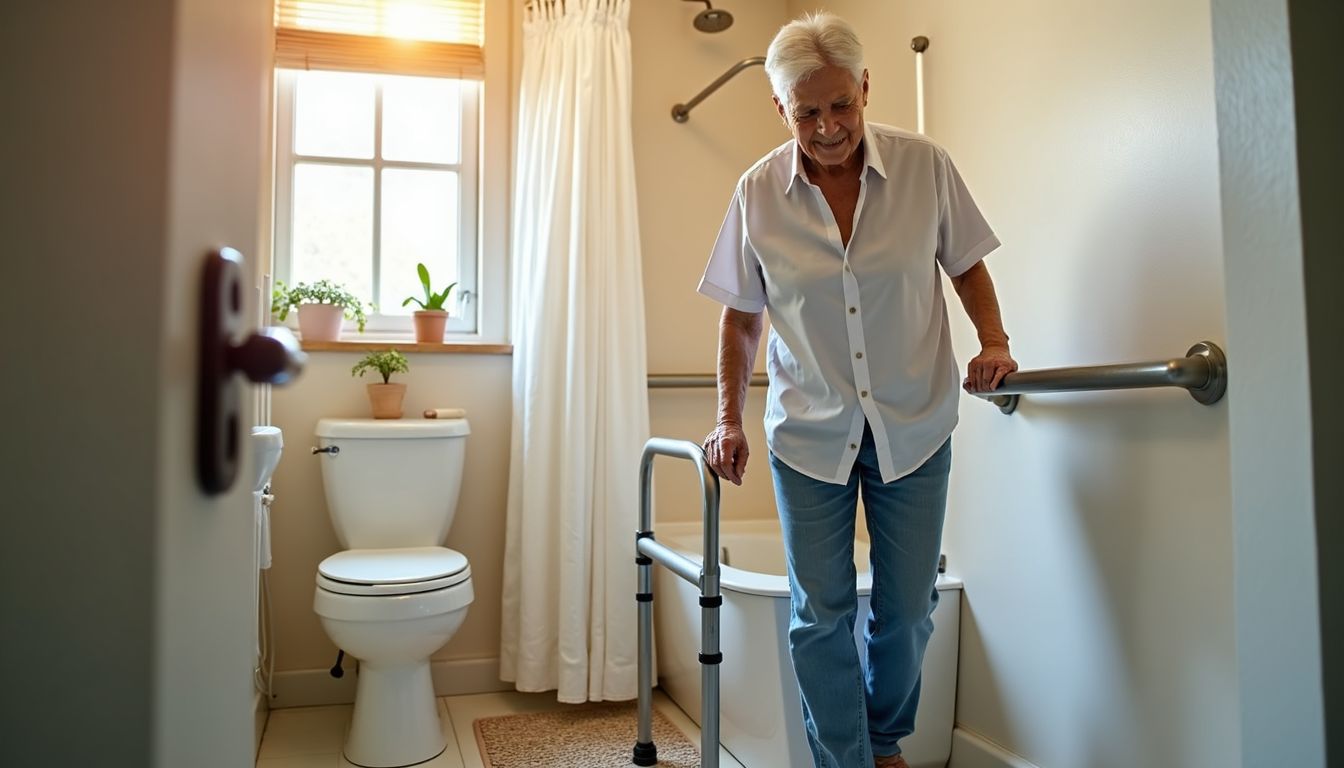Senior-friendly home design focuses on safety, comfort, and independence for older adults. As we age, everyday spaces can present new challenges — from slippery bathrooms to poorly lit hallways. Making a few simple home upgrades, like adding grab bars, better lighting, and slip-resistant flooring, can transform a regular home into a safe and supportive environment for seniors.
However, the home that once felt safe can harbor hidden hazards that increase the risk of falls and injuries. In fact, over half of fall injuries among older adults occur inside the home agesafeamerica.com.
Did you know?
Falls are the leading cause of fatal and nonfatal injuries among older adults, with many occurring at home agesafeamerica.com.
This guide aims to empower you with practical steps to transform your home into a senior-friendly haven. From simple safety upgrades to thoughtful design changes, we’ll explore how to create an environment that supports mobility, independence, and peace of mind. Whether you’re a caregiver, family member, or senior looking to enhance your living space, these insights will help you make informed decisions for a safer home.
2. Common Household Hazards for Seniors
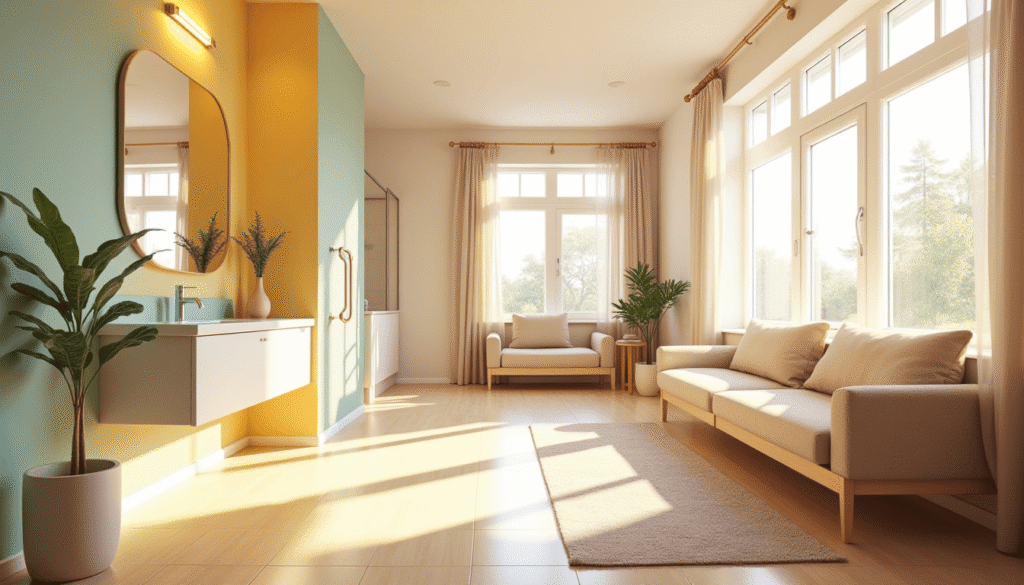
Even the coziest home can hide risks for aging adults. Understanding these hazards is the first step toward creating a safe and supportive environment. Many accidents at home happen because of everyday items and layouts that seem harmless but can become dangerous as mobility, balance, or vision changes with age.
a) Slippery Bathroom Floors and Wet Surfaces
-
Bathrooms are the most common sites of senior falls. Wet tiles, water splashes, and soap residue can make surfaces extremely slippery.
-
Quick tips:
-
Use non-slip mats inside and outside the shower or bathtub.
-
Keep towels and cloths within reach to prevent dripping on the floor.
-
Consider installing grab bars near showers and toilets.
-
-
Internal link suggestion: → Best Shower Chairs for Seniors
b) Poor Lighting in Hallways, Stairs, and Rooms
-
Dimly lit areas can make it difficult for seniors to see obstacles, leading to trips and falls.
-
Shadows on stairs or uneven flooring increase risk.
-
Quick tips: Senior-Friendly Home
-
Install motion-sensor nightlights in hallways and bathrooms.
-
Ensure staircases are brightly lit with no glare.
-
Use contrasting colors for walls, steps, and edges to improve depth perception.
-
c) Loose Rugs, Clutter, and Low Furniture
-
Throw rugs that slide or furniture placed too close together can obstruct walking paths.
-
Low coffee tables or footstools may not be easily visible, causing trips.
-
Quick tips:
-
Remove loose rugs or secure them with non-slip pads.
-
Keep walkways clear of clutter.
-
Arrange furniture to allow wide paths for walkers or wheelchairs.
-
d) Lack of Support Handles or Grab Bars
-
Seniors often need a little extra support when standing up from chairs, beds, or toilets.
-
Absence of support bars increases the risk of falls during daily activities.
-
Quick tips:
-
Install sturdy grab bars in bathrooms and near beds.
-
Consider bedside commodes with built-in handles.
-
-
Internal link suggestion: → Top 5 Bedside Commodes in 2025
e) Other Hidden Hazards
-
Electrical cords stretched across walkways
-
Pets underfoot, especially in high-traffic areas
-
Sloped thresholds or uneven flooring
-
Cluttered kitchens or cabinets that require bending or reaching
By identifying these common hazards, families can take proactive measures to reduce risk, making the home a safer and more comfortable space for seniors.
3. Safety Upgrades for Bathroom, Bedroom, and Stairs
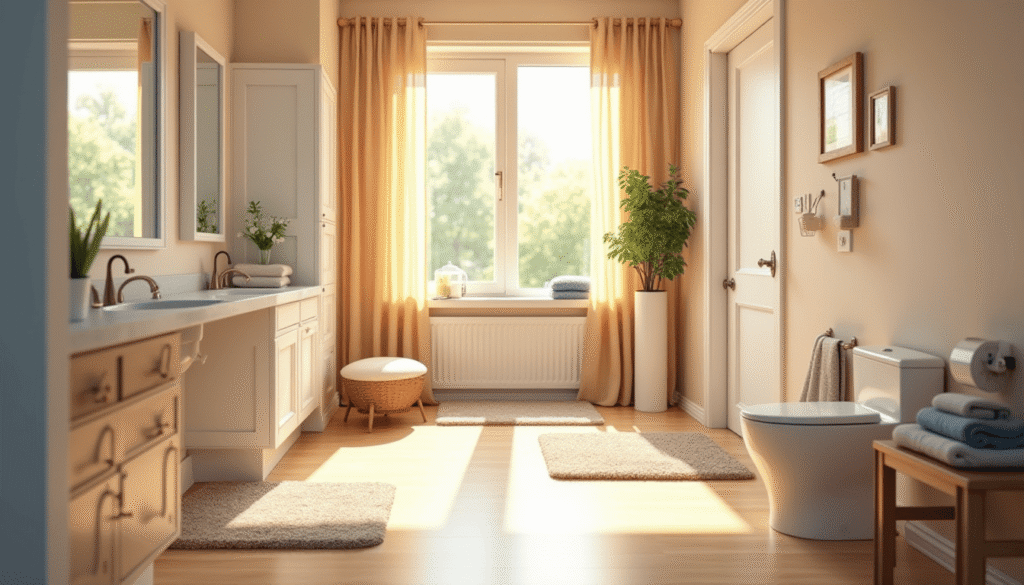
Making targeted upgrades in key areas of the home can drastically reduce the risk of accidents and improve comfort for seniors. Here’s a room-by-room guide to practical changes you can implement immediately.
🛁 Bathroom Safety Upgrades
Bathrooms are high-risk zones for falls, so thoughtful safety improvements are crucial:
-
Install Grab Bars: Place them near the shower, bathtub, and toilet to provide support when standing or sitting.
-
Shower Chairs & Bath Seats: Allow seniors to sit while bathing, reducing fatigue and fall risk.
-
Check Out : Best Shower Chairs for Seniors
-
-
Non-Slip Mats: Use in both the shower and outside on the bathroom floor to prevent slipping.
-
Handheld Showerheads: Reduce movement and make bathing easier for seniors with limited mobility.
-
Bedside Commode Placement: Convenient for nighttime use and reduces risky trips to the bathroom.
-
Check out Our : → Top 5 Bedside Commodes in 2025
-
🛏️ Bedroom Safety Upgrades
Bedrooms are often overlooked but require thoughtful adjustments:
-
Proper Bed Height: Adjust to a height that allows safe sitting and standing.
-
Clear Pathways: Remove clutter and ensure enough space for walkers or wheelchairs.
-
Night Lights: Motion-sensor lamps prevent disorientation during nighttime trips.
-
Accessible Essentials: Keep water, medications, and frequently used items within easy reach.
-
Bedside Commode Integration: Helpful for seniors with mobility challenges.
-
Check Out Our: → Top 5 Bedside Commodes in 2025
-
🪜 Stairs and Hallways Safety Upgrades
Falls on stairs can lead to serious injuries. Proper safety measures make a huge difference:
-
Handrails on Both Sides: Ensure secure and continuous handrails on all staircases.
-
Adequate Lighting: Use bright, glare-free bulbs and motion sensors in hallways and stairways.
-
Non-Slip Treads: Add slip-resistant stair treads or anti-skid strips to prevent accidents.
-
Wide, Clear Walkways: Remove obstacles and ensure paths are wide enough for mobility devices.
-
Mobility Device Access: Make space for scooters or walkers in hallways and entrances.
-
Check Out Our: → Best Mobility Scooters for Seniors
-
Pro Tip: Combining multiple small upgrades—like grab bars, better lighting, and non-slip surfaces—creates a safer environment far more effectively than relying on just one change.
4. Importance of Non-Slip Flooring and Proper Lighting

Two of the most overlooked but critical factors in preventing senior falls are flooring and lighting. Small changes in these areas can drastically improve safety and confidence for aging adults.
a) Non-Slip Flooring
-
Why it matters: Slippery floors are one of the leading causes of household accidents among seniors. Even a minor spill can result in serious injury.
-
Practical tips:
-
Install non-slip tiles, vinyl flooring, or rubber mats in high-risk areas like bathrooms, kitchens, and entryways.
-
Secure area rugs with non-slip pads or remove them entirely.
-
Use textured flooring in wet areas to provide extra grip.
-
-
Extra benefit: Non-slip flooring also reduces caregiver strain by minimizing the need for constant supervision.
b) Proper Lighting
-
Why it matters: Poor visibility can make obstacles, stairs, and uneven surfaces dangerous. Seniors often have reduced vision, making lighting crucial.
-
Practical tips:
-
Use motion-sensor nightlights in hallways, bathrooms, and bedrooms to prevent nighttime trips and falls.
-
Ensure staircases and entryways are brightly lit with glare-free bulbs.
-
Install under-cabinet lighting in kitchens to illuminate countertops and prevent accidents.
-
Consider contrast lighting: edges of stairs or door frames in contrasting colors to make them easier to see.
-
c) Combining Flooring and Lighting for Maximum Safety
-
Together, non-slip flooring and proper lighting create a fall-proof environment.
-
For example, a well-lit bathroom with a non-slip floor dramatically reduces the risk of slips during showers or nighttime bathroom visits.
-
Pro tip: Conduct a “walk-through test” in your home at night to identify any dim areas or slippery spots.
5. Assistive Devices That Improve Independence
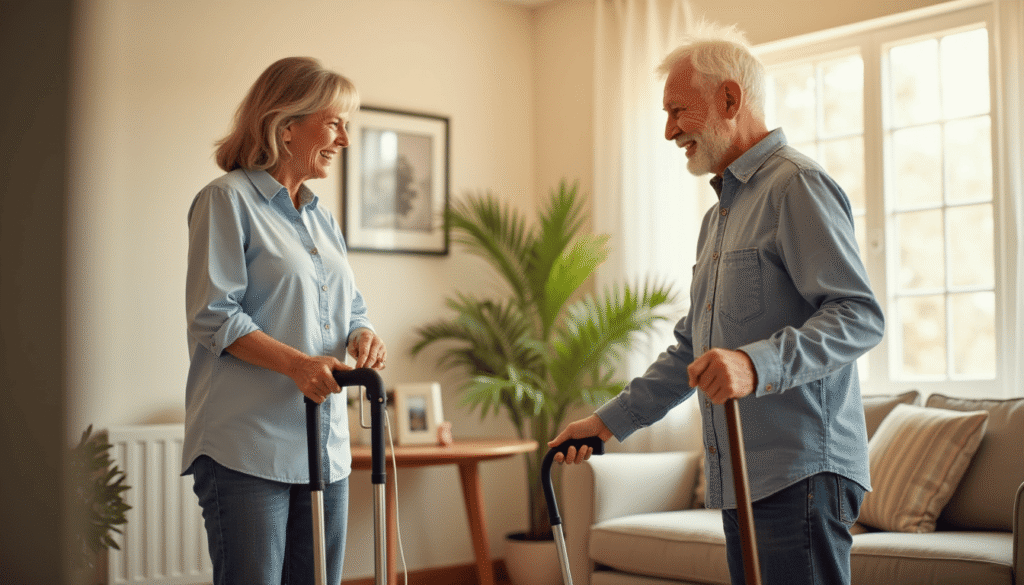
While home safety upgrades like grab bars and non-slip flooring are essential, assistive devices take senior independence to the next level. These tools not only reduce the risk of accidents but also empower seniors to perform daily tasks confidently and comfortably.
a) Mobility Scooters and Walkers
-
Purpose: Provide support for seniors with limited walking endurance or balance issues.
-
Benefits:
-
Allows seniors to move around freely without constant assistance.
-
Reduces strain on caregivers.
-
-
Find Out: → Best Mobility Scooters for Seniors
-
Tips: Choose a scooter or walker with sturdy wheels, adjustable height, and easy-to-use brakes.
b) Adjustable Beds
-
Purpose: Help seniors get in and out of bed safely while supporting proper posture.
-
Benefits:
-
Reduces back strain and risk of falls.
-
Can improve circulation and comfort during sleep or rest.
-
c) Smart Pill Reminders and Medication Organizers
-
Purpose: Ensure seniors take medications on time without confusion.
-
Benefits:
-
Prevents missed or double doses.
-
Some devices send alerts to caregivers for added safety.
-
-
Check Out:
d) Grabbers and Reach Extenders
-
Purpose: Help seniors pick up objects or reach high shelves without bending or stretching.
-
Benefits:
-
Reduces the risk of slips, falls, and overexertion.
-
Makes daily chores more manageable.
-
e) Bedside Commode
-
Purpose: Provides safe access to toilets, especially at night.
-
Benefits:
-
Reduces nighttime trips to the bathroom, lowering fall risk.
-
Offers added support with built-in handles.
-
Pro Tip: Combining assistive devices with home safety upgrades—like grab bars, proper lighting, and non-slip flooring—creates a comprehensive environment that maximizes senior independence while minimizing risks.
6. Home Layout Tips for Caregivers
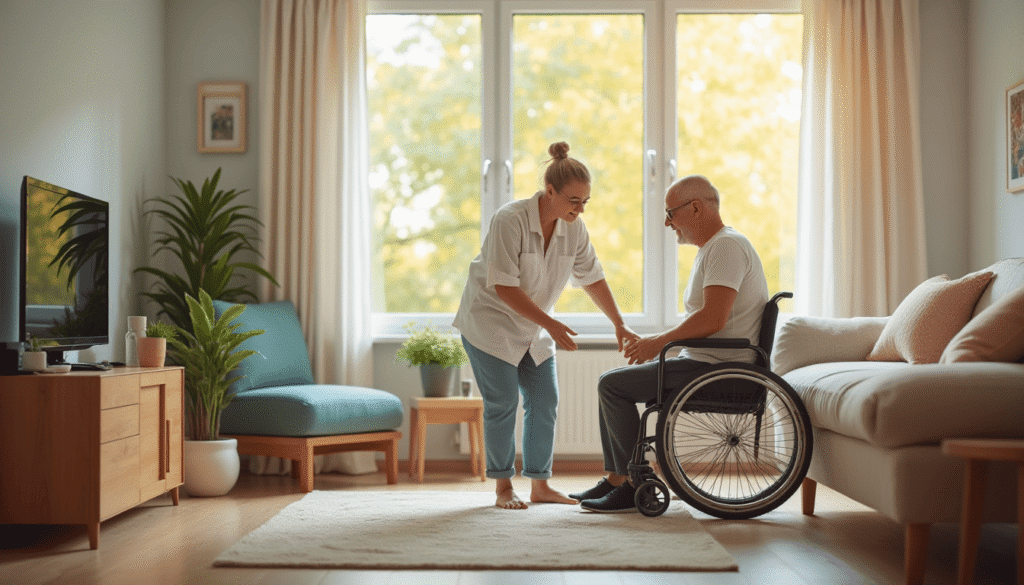
A well-planned home layout is just as important as safety upgrades and assistive devices. Thoughtful organization ensures seniors can move freely, safely, and independently while minimizing risks of accidents.
a) Create Wide Walkways
-
Keep pathways free from furniture, cords, and clutter.
-
Ensure enough space for walkers, wheelchairs, or mobility scooters.
-
Tip: Measure at least 36 inches of clear width in main walkways for easy navigation.
b) Organize Daily-Use Items Within Reach
-
Place frequently used items like medications, cups, and remote controls at waist or eye level.
-
Avoid high shelves or bending into low cabinets to reduce the risk of falls.
-
Use labeled containers or organizers for easy identification.
c) Minimize Sharp Edges and Obstacles
-
Use corner protectors on tables and counters.
-
Remove low furniture or ottomans from main walking areas.
-
Ensure rugs are non-slip or removed entirely in busy areas.
d) Create “Safe Zones”
-
Designate areas where seniors can rest or perform activities without obstacles.
-
Example: A well-lit reading nook or a sitting area near the kitchen.
-
Include supportive furniture like chairs with armrests to aid standing up safely.
e) Use Contrasting Colors for Better Visibility
-
Mark steps, edges, or thresholds with contrasting colors to improve depth perception.
-
Helps seniors differentiate floors, walls, and objects, reducing trips and falls.
f) Plan for Mobility Devices
-
Leave room for scooters, walkers, or wheelchairs in hallways, bedrooms, and entryways.
-
Make sure doors are wide enough and open fully without obstruction.
-
Keep charging stations for powered devices accessible but out of walkways.
Pro Tip: Walk through the home from a senior’s perspective—try sitting, bending, or using a mobility device to identify tricky areas. Adjust layout accordingly to make daily life easier and safer.
Conclusion
Creating a senior-friendly home doesn’t require a complete renovation—small, thoughtful changes can make a big difference in safety, comfort, and independence. From installing grab bars and non-slip mats to improving lighting and rearranging furniture, each step helps reduce the risk of falls and makes daily life easier for aging adults.
By combining home safety upgrades, assistive devices, and smart layout adjustments, you can empower seniors to live confidently and independently in their own space. These changes not only protect physical health but also enhance mental well-being, providing peace of mind for both seniors and their caregivers.
Taking these steps today can transform your home into a safe, comfortable, and empowering environment for your loved ones. Start with one improvement at a time, and watch how it enhances their quality of life.



